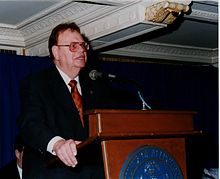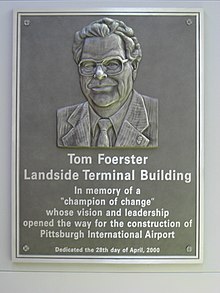|
Tom Foerster
Thomas J. Foerster (April 17, 1927 – January 11, 2000) was an American Democratic politician. Foerster held a variety of political positions in Allegheny County, Pennsylvania, and was seen as one of the last "machine" politicians from the area.[by whom?] CareerA native of Pittsburgh, Foerster was active in athletics while a high school student, and while attending Slippery Rock College (now a university). He also began coaching youth football.[4] State HouseFoerster unsuccessfully sought a seat in the Pennsylvania State House in both 1954 and 1956. He was successful in his third bid in 1958, winning one of Allegheny County's allotted at-large seats by defeating former Steelers quarterback John "Harp" Vaughn. Foerster joined Leroy Irvis (who would go on to serve as the first African American Speaker of the State House) and State Senator Eugene Scanlon in a much-heralded freshman legislative class. While in the State House, he championed the cause of outdoorsmen and environmentalists, distinguishing himself by authoring Pennsylvania's Clean Streams Law.[4] Board of CommissionersFoerster was persuaded[by whom?] to run for one of the three seats on Allegheny County's Board of Commissioners in 1967. He received significant backing from the political machine of former Pittsburgh Mayor David Lawrence, whom Foerster had long admired. Lawrence, who had been elected Governor the same year Foerster won his State House seat, supported Forester and his running mate, former State Senator Leonard Staisey. Together, Staisey and Foerster toppled incumbent Democratic Commissioners William McClelland and John McGrady in the primary election. Foerster would go on to be re-elected to the Board of Commissioners a record six more times.[4] In 1977, he was the Democratic nominee for Pittsburgh Mayor. However, he lost the general election to incumbent Mayor Richard Caliguiri, who ran as an independent.[citation needed] As chairman, he initiated a plan to establish home rule in Allegheny County, which would replace the county commission with an elected County Executive and a County Council. This initiative was based upon a study set into motion by him and county commissioner Pete Flaherty in 1995. They established a committee chaired by the then Chancellor of Duquesne University, John E. Murray, Jr. called "ComPAC 21", (The committee to Prepare Allegheny County for the 21st Century). Their report laid the plan for a completely new organizational structure of county government.[5] The new form of government recommended by the study was advanced by the subsequent board, voted upon via a county-wide referendum, and officially instituted in 2000, and he became the first person to represent the 13th district on the council, which replaced the County Board of Commissioners.[6] He was defeated in the Democratic primary in his bid for an eighth term in 1995. That fall, Republicans Bob Cranmer and Larry Dunn both won seats on the Board, forming the first Republican majority in six decades.[citation needed]  County CouncilIn 1999, Foerster was elected to the Allegheny County Council, which was created by the enactment of Allegheny County's home rule charter in 1998.[7] He became the first person to represent the 13th district on the council, which replaced the County Board of Commissioners.[6] DeathFoerster died on January 11, 2000, just eleven days into his term, from complications of cardiac arrest and diabetes. He was 72 years old and had been in a coma for nearly a week. He was survived by his wife, Georgeann, and five stepchildren.[4] References
External links |
||||||||||||||||||||||||||||||||||||||||||
Portal di Ensiklopedia Dunia
